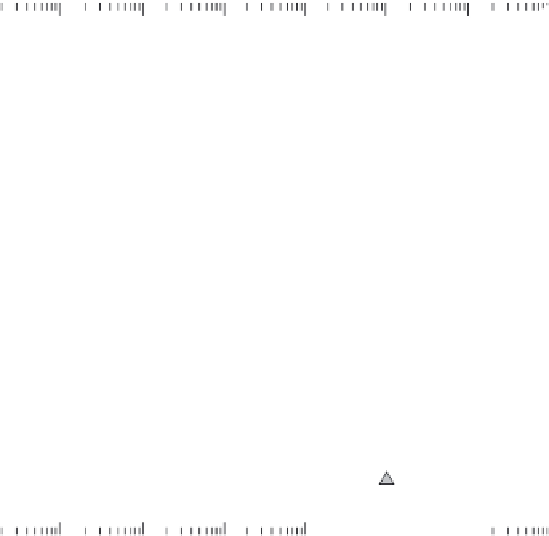Environmental Engineering Reference
In-Depth Information
Since Pe
m
>
10, molecular diffusion has a relatively
small contribution to longitudinal dispersion, but since
Pe
m
< 100, molecular diffusion will contribute signifi-
cantly to transverse dispersion.
(1992) and are shown in Figure 5.9. Data from these
sites yielded 106 values of longitudinal dispersivity, in
the range of 0.01-5500 m (0.03-18,000 ft) at scales of
0.75 m-100 km (2.5 ft-62 mi). Based on the results
shown in Figure 5.9, it is clear that the longitudinal dis-
persivity increases with the distance traveled by
the contaminant cloud (i.e., scale), indicating that
field formations are seldom homogeneous, and that
the variability in hydraulic conductivity increases with
scale. Of all the experiments reviewed by Gelhar et al.
(1992), only 14 studies were considered to provide
highly reliable estimates of the dispersivity, a further
31 values were considered of intermediate reliability,
and the most reliable dispersivity estimates were at
the lower end of the length scale. In the absence of
field measurements of the hydraulic conductivity,
from which the spatial statistics are parameterized by
〈
Y
〉,
σ
Y
, and
λ
, Figure 5.9 provides a useful basis for
estimating the dispersivity in porous formations. The
length scale,
L
, in Figure 5.9 can be taken as either the
distance traveled by a tracer released from a point or
the length scale measuring the size of the tracer cloud.
In either case, the length scale,
L
, measures the spatial
extent of seepage velocity variations experienced by the
tracer cloud. Analyses by neuman (1990) indicate that
In most practical cases, longitudinal dispersion is
dominated by macrodispersion, horizontal-transverse
dispersion is influenced significantly by temporal varia-
tions in the seepage velocity, and vertical-transverse
dispersion is dominated by small-scale hydrodynamic
dispersion (Rehfeldt and Gelhar, 1992). Field studies
indicate that horizontal-transverse dispersivities can be
related to longitudinal dispersivities using a ratio of
longitudinal to horizontal-transverse dispersivity in the
range of 6-20 (Anderson, 1979; Klotz et al., 1980). The
horizontal-transverse dispersivity is usually much larger
than the vertical-transverse dispersivity. Common prac-
tice is to estimate the longitudinal dispersivity using a
theoretical or empirical relation such as Equation (5.36),
estimate the horizontal-transverse dispersivity as one-
tenth of the longitudinal dispersivity, and estimate the
vertical-transverse dispersivity as one-hundredth of the
longitudinal dispersivity.
Longitudinal dispersivities derived from 59 sites
around the world have been collated by Gelhar et al.
10
4
10
3
10
2
10
1
10
0
10
-1
Reliability:
low
10
-2
intermediate
high
10
-3
10
21
10
0
10
1
10
2
10
3
10
4
10
5
10
6
Length scale (m)
Figure 5.9.
Longitudinal dispersivity versus length scale in groundwater.
Source
: Gelhar et al. (1992). Reproduced by permission
of the American Geophysical Union.






























































































Search WWH ::

Custom Search